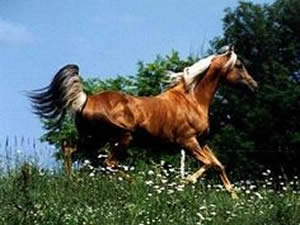History
In 1857, D. C. Lindsley, a notable horse historian, wrote an essay entitled The Morgan Horse. In the essay, he recommended cross-breeding Morgans with Arabian mares if no pure-blood Morgan mares could be obtained, leading to a cross-breed which became known as the Morab.
One of the descendants of these crosses was Golddust, a famous walker and trotting horse who was very successful in the show ring and on the race track. He sired 302 foals, and over 100 Morab horses today can be traced back to him.
The next mention of Morgan-Arabian cross-breeds comes in the 1920s. Publisher William Randolph Hearst had an extensive Arabian breeding program and a short-lived, but important, Morgan program, which included a program of breeding Morabs. Hearst is credited with having coined the word "Morab" for crosses between the two breeds.
Hearst bred Morabs by crossing Crabbett-bred Arabian stallions to working Morgan mares. Mrs. William Randolph Hearst II said in her book Horses of San Simeon that Hearst, "... found the produce were excellent for work on his California Ranch." "He registered 110 horses in the AMHA, 18 of which were Morabs", she said. Quoted in an early American Morab Horse Association Brochure, "According to A. J. Cooke of the Hearst Corp, Sunical Div. … Hearst bred Morabs in the 1930’s and 1940’s for ranch work … and were desirable for the large, rough, mountainous terrain of the Hearst Ranches."
Another Morab breeding program was developed by the Swenson Brothers near Stamford, Texas on their SMS Ranch. Starting from two Morgan stud colts, seven Morgan brood mares, and three Arabian stallions, their program created several notable Morab horses.
Another highly influential breeding program was established in Clovis, California, by one Martha Doyle Fuller. In 1955, after several disappointing attempts to breed a horse that could successfully compete on the open show circuit, Mrs. Fuller developed a Morab breeding program focusing on show discipline capability and what she called "Morab type".
Behavior
The Morab's temperament and personality is best described as a true combination of the Morgan and the Arabian. Morabs are generally very intelligent, curious, and personal horses. They are often very quick to learn, and establish strong relationships with humans, who they are eager to please. Morabs make excellent family horses, and are sometimes used as lesson and therapy horses.
Function
Dressage, eventing, jumping, endurance, gymkhana, driving, cutting, reining, stock, equitation, park, parade, trail, and pure pleasure.






